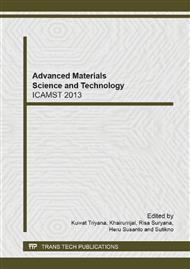p.423
p.428
p.434
p.440
p.444
p.451
p.455
p.459
p.464
Experiment Using a Magnetically Controlled Ferrofluid Flow in a Flatplate Laminar Flow System
Abstract:
The Phenomenon of a Magnetic Controlled Ferrofluid Flow in the Flat Plate Laminar Flow System is Discussed in this Paper. the Ferrofluid Flow is One Kind of Colloid Mixture, which is Composited by the Magnetic Particles, Carrier Fluid and Surfactant. its Motion is Followed the Fluid Dynamics and can be Controlled by a Magnetic Field. from the Theoretic Analysis and the Experimental Test, the Coefficient of Viscosity of the Ferrofluid Flow will be Affected by the Magnetic Field. Thus, an Experimental Rig is Built to Test the Influences of the Gap of the Plate and the Strength and Direction of the Magnetic Field for Several Ferrofluid Flows with Different Dividing Rates of Volume. Experimental Results Showed that the Coefficient of Viscosity of the Ferrofluid Flow is Almost Not Upgrading in a Wide Gap Condition by the Magnetic Field, but as the Gap is Smaller, the Coefficient of Viscosity will be Promoted Obviously. Furthermore, Enhancing the Magnetic Field, it will be Increase the Coefficient of Viscosity of the Ferrofluid Flow. from the Experimental Results, the Relationship of the Magnetic Field, Coefficient of Viscosity of Ferrofluid Flow and the Carrier Fluid can be Confirmed.
Info:
Periodical:
Pages:
444-447
Citation:
Online since:
February 2014
Authors:
Keywords:
Price:
Сopyright:
© 2014 Trans Tech Publications Ltd. All Rights Reserved
Share:
Citation:


